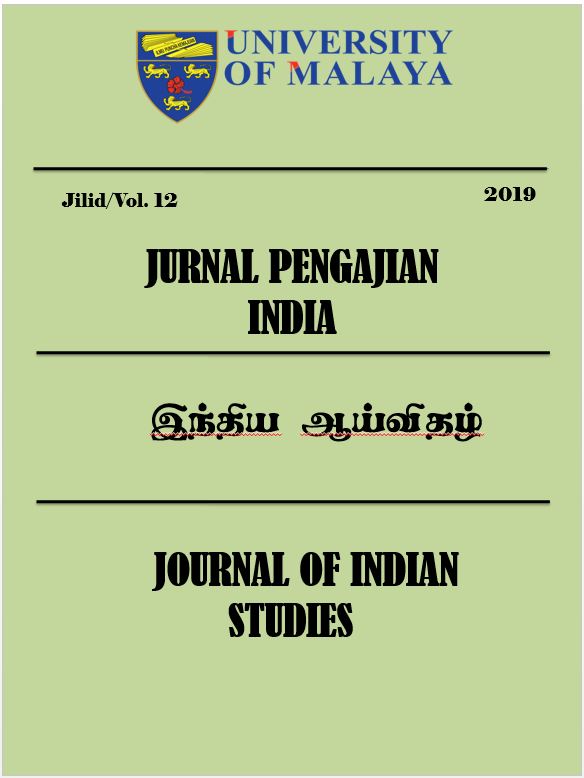வினைச்சொற்கள் கற்றல்-கற்பிப்பதில் பின்னோக்குப் போதனைமுறை உத்தி (Reversal Teaching Technique in Teaching and Learning Verbs)
DOI:
https://doi.org/10.22452/JIS.vol12no1.3Keywords:
Teaching Tamil Verbs, Backformation Strategy, Reversal Strategy, Tamil Verbs, Tamil Grammar., தமிழ் வினைச்சொற்கள் கற்பித்தல், பின்வடிவாகம் உத்தி, பின்னோக்குப் போதனாமுறை உத்தி, தமிழ் வினைச்சொற்கள், தமிழ் இலக்கணம்,Abstract
Teaching Tamil grammar is a tough exercise for many educators. Teaching verbs and its extension components were even difficult, as some instructors usually found it hard to master and teach the verbal extension and its system attractively. The incapability as this made the ways of understanding them properly also hard among the student as well. Teachers who use the old taxonomy methods as the best tools to teach the grammar in their pedagogy found that there were so little rooms were available for innovations. As an alternative, the author has offered an unconventional method so-called, Back-formations in teaching the system of verb and its extension in Tamil. The article is aimed at introducing verbs and verbal system teaching and learning, which are considered to be a particularly difficult category in Tamil grammar, using an innovative strategy. The approach has been proposed after having tested the strategy and its effectiveness among the students at higher educational levels (HSC and University). The strategy is believed to ease the ways of explaining the grammatical features coherently to the upper secondary students as well. The approach does not promote teaching the division of verbs from the roots, feet, words, and so on as highlighted by the traditional grammarians; alternatively it promotes a reversal form of teaching. This innovation is expected to ease and favor the teaching activities to a great level.
ஆய்வுச் சுருக்கம்
தமிழ் இலக்கணக் கற்றல் கற்பித்தல் என்பது கடுமையான ஒன்று என்பது பலரது பார்வை. அதிலும் வினைச்சொற்களைக் கற்பிப்பது சற்றுக் கடினம். இந்தக் கடினத்துவம் மாணவரது மனதில் இருப்பினும், போதனையாளர்களின் மனதில் ஆழமாகவே உள்ளது. இலக்கணம் என்பது எட்டிக்காய் உண்பது எனும் எண்ணத்தில் பார்க்கும் ஒரு சில போதனையாளர்களின் பார்வை இப்பாடப் போதனையினை மேலும் சிரமமாக்குகின்றது. மலேசியா போன்ற நாடுகளில் தமிழ் மொழியினை இரண்டாம் மொழியாகக் கற்பிக்கப்படும் வேளையில், இதன் சிரமநிலை மேலும் பன்மடங்கு ஆகுகின்றது. போதிய ஆழ்நிலை இலக்கண ஆளுமையின்மையும் இந்நிலையினை மேலும் சிரமாமாக்குகின்றது. இத்தகைய சூழலில் தமிழ் இலக்கணத்தில் குறிப்பாக சிரமமான பிரிவாகக் கருதப்படும் வினைச்சொற்களை அறிமுகம் செய்து அவற்றின் இலக்கணக் குறிப்புகளை இலகுவாக விளக்கிடும் ஒரு முறைமையினை, குறிப்பாக உயர் இடைநிலை மாணவர்களுக்கு அறிமுகம் செய்யும் நோக்கினில் இக்கட்டுரை வடிவமைக்கப்பட்டுள்ளது. வினைச்சொற்களை வேர், அடி, சொல், தொகை, தொடர் எனப் பிரித்துப் போதனை செய்யாது, எதிர்நிலை முறையில், பின்வெட்டாக்க முறையினில் போதிப்பதை இம்முறைமை அறிமுகம் செய்கின்றது. இந்தப் புதுமை முயற்சி ஆசிரியர்களுக்குப் பேருதவியாக அமையும் எனலாம்.

